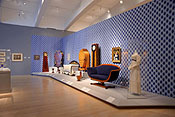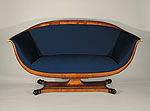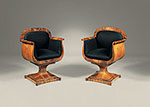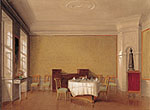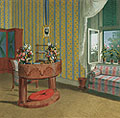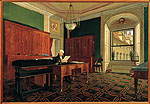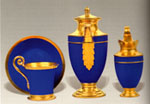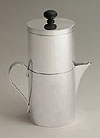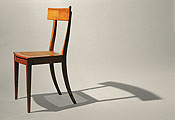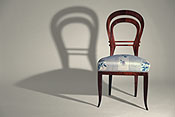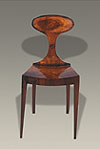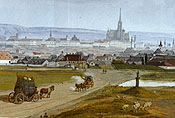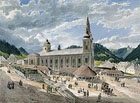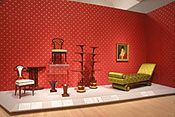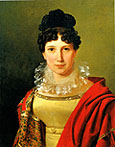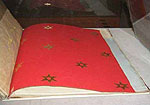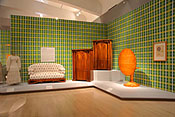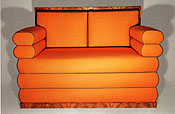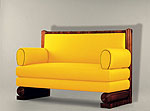The browser will either open the file, download it, or display a dialog.
|
Biedermeier, The Invention of Simplicity Milwaukee Art Museum: September 16, 2006-January 1, 2007 Biedermeier, The Invention of Simplicity |
|||
| It's not often that a museum develops an exhibition that creates a major shift in art historical understanding of a particular period, style or artist. Biedermeier, The Invention of Simplicity, organized by the Milwaukee Art Museum in collaboration with the Deutsches Historisches Museum in Berlin and the Albertina in Vienna, is one of those rare exceptions. The overarching goal of this exhibition is the re-examination of the Biedermeier aesthetic in Central Europe from 1815 to 1848. With a stunning display of over 400 objects, the show includes paintings, drawings, decorative arts, and sculpture, as well as cultural artifacts—such as scientific instruments and clothing—that inform the larger social context. The exhibition is not only ambitious in scope, but also in its intellectual objective of presenting a coherent body of work that defines the Biedermeier period in a clear historical framework. Laurie Winters, curator of Earlier European Art at the Milwaukee Art Museum, deserves much credit for nurturing collaboration among the international scholars who have been redefining aspects of the Biedermeier period in recent decades. It should also be noted that this is the first time that an American museum has ever generated an exhibition on this subject. | ||||
| Entering the first gallery, it is immediately clear that any preconceptions about the definition of "Biedermeier" must be discarded. This viewer's impression was that I'd stumbled into an exhibition on early modernism by mistake—and that is precisely the point that the curators wish to make. Winters defines the stylistic characteristics of Biedermeier succinctly in the excellent catalogue accompanying the exhibition: "purity and abstraction of form, brilliant color, lack of superficial ornamentation, and a sensitive appreciation for and reliance on nature" (39). These traits are apparent in the dramatic display of furniture facing the main entrance into the gallery. Installed on a low base against a dazzling blue and white diamond-patterned wallpaper are two long case clocks, two settees, and two cabinets that proclaim a clear preference for geometric purity of form, and a taste for revealing the natural beauty of wood veneers (fig. 1). The Austrian settee and chairs from 1820 looks like nothing so much as 1950s pedestal furniture by Eero Saarinen (figs. 2, 3). Not only are these pieces strikingly modern in form, but the emphasis on natural wood grains seems almost a precursor to the Japonisme that will emerge later in the nineteenth century. This initial presentation of Biedermeier design very effectively challenges many assumptions about early nineteenth-century aesthetics. Any lingering thoughts about stodgy middle-class furnishings or sentimental revivalism must be shelved in light of the crisp elegance of the artworks on display. | ||||
| The theme of this first gallery is "Cultural Life", which appropriately sets the stage for an understanding of the Biedermeier aesthetic as well as the social context in which it developed. Once the initial impact of such unexpected modernity abates, the exhibition's scope begins to unfold. In the small grouping of watercolor zimmerbilder, or 'room portraits', the viewer is introduced to a uniquely Biedermeier genre of recording interiors as documentation of both social status and personal history (fig. 4). Although related to French architectural drawings and interior views, the zimmerbilder are not primarily design documents, but rather records of an individual's taste. As Laurie Stein notes in her essay on "Interior Views," the "Zimmerbild can be understood as an abstracted portrait of the inhabitant" (148). Often these charming images were made to commemorate transitional moments in life—as a memorial for someone who has died or as a parting gift to a child who has married and moved away. This very private form of imagery was typically pasted into family albums or incorporated into souvenir collections, where it remained inaccessible to outsiders. Fortunately, the family albums in many cases belonged to Central European aristocratic kinship networks, and thus were preserved for posterity. The 1826 zimmerbild of Duchess Sofie's newly furnished apartment in the Blauer Hof in Laxenburg is a case in point (fig. 5). Painted by Johann Stephan Decker, this refreshing interior rendering illustrates the beautiful grain of the Biedermeier writing desk, the bright blue and yellow wallpaper, and the elegant simplicity of this very personal space; and for many decades it belonged to Queen Elizabeth of Prussia. | ||||
| The relationship between the Biedermeier period and the aristocracy is another unanticipated aspect of this exhibition. The conventional interpretation of Biedermeier design has been that it was a middle-class phenomena largely based on a desire for modest furnishings that could be purchased at a modest cost. This interpretation was challenged as long ago as 1986 in Christian Witt-Dörring's essay on furniture in the exhibition catalogue for Bürgersinn und Aufbegehren: Biedermeier und Vormärz in Wien 1815-1848 mounted by the Historisches Museum der Stadt Wien; and, in 1987 by Hans Ottomeyer in the Münchner Stadtmusseum exhibition catalogue, Biedermeiers Glück und Ende: die gestörte Idylle. However, these re-evaluations of the Biedermeier style were not widely recognized outside of German-speaking regions. One of the important benefits of the current exhibition is the availability of the catalogue in English and the international exposure resulting from venues in the United States and France as well as Berlin and Vienna. In his essay, "The Invention of Simplicity," for the current exhibition catalogue, Ottomeyer explains that Biedermeier was fundamentally an aristocratic style. It "originated in commissions for private domestic interiors by aristocratic and royal patrons. It evolved initially from the court and thereafter spread into a more broad based usage among the new moneyed social classes"(45). One of the sources for this 'invention of simplicity' was Jean-Jacques Rousseau, the French philosophe whose educational methodology, as articulated in Emile (1762), was widely implemented among monarchs and aristocrats in the nineteenth century. Just as Rousseau's idealized main character, Emile, demonstrated the virtues of his naturally unpretentious character, so too aristocratic children were raised to embrace plainness and simplicity, presented in an understated manner (fig. 6). | ||||
| Having absorbed at least the broad outlines of this understanding of the Biedermeier aesthetic, the viewer can then turn to the smaller scale objects in the gallery with a more knowledgeable eye. Porcelain ware and silver objects fill six vitrines in the center of the room, again surprising in its minimal ornamentation and use of bright color. For example, the blue and gold porcelain Coffee Service from Nymphenburg (1825) demands the viewer's attention with its deep blue surfaces and bold applications of gold leaf (fig. 7). Although related to earlier aesthetics, this is neither the pastel blue of the rococo nor the understated hue of neoclassical ceramics. Instead it is a clear, straightforward articulation of intense color and clearly defined shapes. Similarly, the silver pieces in these vitrines are astonishing in their clean precise lines and pure geometric shapse. In fact, the Viennese Coffee Pot and Percolator (1818) might have come from the workshops of the Bauhaus more than a century later (fig. 8). | ||||
| In the second gallery, the focus is on chairs, chairs, and more chairs. There are straight chairs with beautiful veneers such as the beech wood chair designed by Karl Friedrich Schinkel in 1825 where the curved back and splayed back legs suggest a welcome awareness of the configuration of the human spine, and the elegant unadorned line allows the beauty of the natural wood to shine (fig. 9). There is a Viennese chair from 1826 with a similar elegance of line, but with a curving open back carved from a single piece of beech wood (fig. 10). Designed for Danhauser'sche Möbelfabrik, a very early ready-made furniture showroom established by Josef Danhauser, this type of chair presages Thonet's famous bentwood chair; the difference is that Danhauser carved his curved forms from solid wood rather than creating them by bending the steamed wood. In contrast, a Bohemian chair from 1815 presents an even more minimalist approach with a mesmerizing walnut veneer on the back with a dramatic pattern cut from the center of the tree (fig. 11). Perhaps less comfortable than the other two chairs, it is nonetheless an object to be admired purely for the natural beauty it reveals. | ||||
| The furniture display was augmented in this gallery with an installation of ironwork, including two iron portrait busts, in the center of the space as well as paintings of cityscapes on the walls. As Cornelia Reiter remarked in her essay on "Central European Painting and Drawing", city scenes were "core subjects" for Biedermeier painters, in part because this type of scene was particularly suitable for visual artists who were concerned with capturing empirical reality (284). Eschewing romanticism as well as neoclassical history painting, the artists of these cityscapes were certainly aware that there was a market for contemporary, regionally focused vedute in the tradition of Canaletto. Jakob Alt's 1817 watercolor, View of Vienna from "Spinnerin am Kreuz," exemplifies this trend with a precisely delineated vista of the city, undoubtedly destined for the home of a wealthy entrepreneur (fig. 12). | ||||
| The third gallery continues this exploration of Biedermeier painting, this time with an emphasis on Alpine landscapes, and one of the more intriguing features of the exhibition, The Emperor's Peepshow. Despite the salacious-sounding title, this 'peepshow' consisted of a series of over 300 watercolor views of scenic highlights of the Austrian Empire, commissioned in 1833 by the archduke Ferdinand who would eventually become Emperor Ferdinand I. These large-format watercolors were viewed through a box equipped with a concave mirror so that the images appeared to be three-dimensional projections. Eduard Gurk's work, The Basilica of Mariazell Seen from the Churchyard (1833) was one of many that were part of the Peepshow image bank (fig. 13). Here the imposing basilica of Mariazell is surrounded with lively activity, most of which appears to have little to do with religious services or events. Rather, it is a portrait of a place just as the zimmerbilder are portraits of rooms—in this case perhaps an extension of the Austro-Hungarian Empire's national identity as it was embodied in the landscape. | ||||
| This gallery might also be dubbed the "red gallery" for the gold star-studded red wallpaper that forms the backdrop to another furniture installation (fig. 14). Here the curators have hung chairs on the wall as well as Ferdinand Waldmüller's1822 portrait of the fashionable Catharina Baroness von Koudelka, dressed in a yellow-green gown with a bright red shawl (fig. 15). Most surprising is the juxtaposition of the stylish baroness' portrait with a graceful daybed upholstered in an acid green fabric that contrasts with the starry scarlet wallpaper in a startling reiteration of the colors of the baroness's clothes. This intensely colored and rather tart contrast serves to remind the viewer that the simple forms that characterize the Biedermeier aesthetic do not imply innocuous design. | ||||
| Nearby, the red theme is underscored with a display of hyalith glass, an exceptionally hard dark red glass developed in Count Georg of Buquoy's glasshouse near Gratzen in Bohemia (fig. 16). Jutta Annette Page, author of the catalogue essay on glass, explains that hyalith glass was part of a "quest for complex colored glass formulas" (203). Count Georg was the first to succeed in creating a completely opaque—and very durable—material that he christened "hyalith" to signify that it was a "glass stone". Initially this new glass was made in black, but the Georgenthal glasshouse also produced a glistening red hyalith that emphasized minimalist forms and the beauty of the blown glass. | ||||
| A taste for brilliant color, natural materials, and simple forms also found expression in porcelain decorated with botanical imagery, often based on scientific publications. The nineteenth-century European fascination with overseas exploration, and the categorization of new species, is particularly evident in the use of natural history collections as source materials for the extensive dinner sets produced throughout the German-speaking world. Albrecht Pyritz's catalogue essay on porcelain details the history of this development, noting that the market for this type of porcelain continued to thrive well into the 1840s (186-187). In the fourth gallery of the exhibition, a large selection of these porcelain wares was displayed in conjunction with similarly decorated glassware to create a strong sense of how these sets might have been used in daily life. | ||||
| This gallery also contains one of the most intriguing set of objects in the exhibition; a series of wallpaper sample books that seem to have been preserved in environmentally controlled conditions since the day they came off the presses (fig. 17). The quality of the printing—and perhaps more importantly, the quality of the preservation—is remarkable. Although the catalogue essay by Sabine Thümmler does not address this issue, the sample books were loaned by two institutions, the Technisches Museum Wien and the Staatliche Museen in Kassel, both of which deserve kudos for their stewardship of these fragile documents. The manufacture of paper wallpaper begins in the late eighteenth century, but expands dramatically in the early nineteenth century. Increasingly sophisticated printing techniques facilitated the production of complex patterns such as plaids and iridescent effects, which in turn nurtured the Biedermeier love of color. The curators have made this point abundantly clear in their use of wallpapered partitions in several galleries; these wallpapers were created from the sample books in the exhibition specifically for this purpose. (The Biedermeier wallpapers were recreated by StudioPrintworks of Chicago.) The green and yellow plaid wallpaper was particularly striking (fig. 18). By contemporary tastes, this combination of contrasting colors might seem overly bright or forceful, and yet it is an ideal counterpoint to the understated furniture that accompanies it. | ||||
| At the heart of this fascination with color was the 1810 publication of Johann Wolfgang von Goethe's book Theory of Colors in which he lays out his understanding of complementary shades, visual harmonies, and the optimal uses for neutrals in relation to color. In fact, Goethe himself is known to have designed wallpaper for such illustrious colleagues as Friedrich Schiller (174). Goethe's exploration of color theory receives pride of place in the final gallery where several plates from Theory of Colors as well as a large color wheel were displayed. In addition, there were a number of the writer's wallpaper designs in which he gives visual form to his theories. Although Goethe's science was questioned even in his own time, his perception of how color affects psychological well being remains valid, as does his understanding that afterimages of complementary colors remain in the eye. As if to underscore Goethe's point some two hundred years later, the curators positioned two breathtakingly brilliant settees in orange and yellow next to the color theory materials (figs. 19, 20). | ||||
| For anyone interested in the history of design or aesthetics, this exhibition should be on the "must see" list, as should the exhibition catalogue which received The New York Times 2006 award for Best Decorative Arts Book. More importantly, the catalogue provides a coherent and detailed compendium for an overlooked and largely misunderstood field within nineteenth-century studies. This reader would have appreciated more accessible source citations so that I could have noted them as I read without flipping back and forth through the substantial text. I also wonder why the catalogue entries were separated from the related images. This was bewildering as well as awkward. However, the merits of the catalogue far outweigh these pragmatic difficulties in usage. | ||||
| Biedermeier, The Invention of Simplicity is an exhibition that is long overdue. It offers a necessary intellectual adjustment to a long-standing misperception of this aesthetic, as well as an opportunity for art historians, especially those who do not read German, to broaden their scope. As a re-evaluation of early nineteenth-century design history, it is hard to over-estimate the importance of this exhibition. It brings contemporary German scholarship to a wider audience and initiates a serious discourse on the seminal role of the Biedermeier aesthetic on the development of modernism. | ||||
| Janet Whitmore Harrington College of Design janetwhitmore[at]earthlink.net |
||||


